
















Amal and Rita are visiting China.
The Great Wall of China Kinesiska Muren amazing fantastisk forever för evigt the 5th century 400-talet BC = Before Christ före Kristus keep out stänga ute invaders inkräktare, angripare World Heritage Site världsarv
AMAL This place is amazing!
RITA Yeah it’s fantastic! It goes on forever; you can’t see the end of it. I wonder how long it is?
AMAL It’s over 8,500 kilometres long and was started in the 5th century BC.
RITA That’s really old. Why was it built?
AMAL To keep out invaders of course – why else would they build a wall?
RITA I don’t know – to keep people in. How come you know so much about it?
AMAL From this book – it’s all about the most famous World Heritage Sites.
RITA The most famous what?
ancient forntida the Royal Crown Jewels kronjuvelerna (i England) huge enorm, jättestor tomb grav doubt tvivla på wonder underverk hang on vänta lite
AMAL World Heritage Sites – they’re really special places all over the world. They’re cultural or ancient or just really beautiful natural places. There are over 900 of them.
RITA Can I see? These places look fantastic.
AMAL Yeah, they do.
RITA The centre of Prague; I’ve always wanted to go there... the Acropolis in Athens... the Tower of London where they keep the Royal Crown Jewels...
AMAL It’s a huge list.
RITA Glaciers in Argentina... a dinosaur park in Canada... tombs in Uganda.
AMAL Great isn’t it? I wonder if anyone has visited them all?
RITA I doubt it – it would take years.
AMAL So let’s do it.
RITA What do you mean?
AMAL From now on, every holiday, every chance we get, we visit World Heritage Sites. See how long it takes us to visit them all.
RITA See the wonders of the world! Hang on, where are you going?



AMAL Off to find a train timetable. There are 40 sites in China – we need to get moving if we are going to see them all.
RITA But we’ve only just arrived! What about the Great Wall?
AMAL I’ve already ticked it off the list. Come on... We have to hurry!
RITA I don’t think you really understand ... Oh, OK... I’m coming.



Some stories become so famous that they become a legend. This is one of those stories.
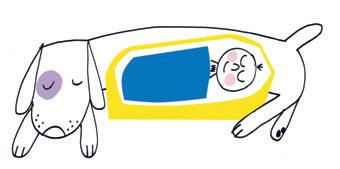
prick up one’s ears spetsa öronen market marknad guard vakta invitation inbjudan painful smärtsam bite bett
Rex was sleeping next to baby Anne when he heard a strange noise. His ears pricked up. He sniffed, and suddenly he knew that someone or something was out there. Every week, when Farmer Soames and his wife went to the market, they left Rex to guard the house. Rex was a small dog but very strong and intelligent. Everybody in the village knew that to come to the house without an invitation meant a painful bite. So nobody did.

But now, Rex could hear someone coming closer. It must be a stranger. He stood up and with his teeth he gently pulled the blanket up over Anne’s shoulders to keep her warm. He turned and faced the door. Outside, it was dark. It was raining hard. Rex pushed the door open with his nose. Cold air. He couldn’t see anything, but his keen dog nose could smell something familiar but dangerous. Rex took a single step out, not wanting to go any further; not wanting to leave baby Anne alone. He turned and looked at her. After Farmer Soames there was no other human he loved so much. She almost felt like his own pup.

stranger främling gently försiktigt blanket filt face stå vänd mot push open knuffa upp keen skarp single enda familiar välbekant further längre pup valp another ett…till, ännu ett

Another sound. That sounded like a growl. But it couldn’t be! Rex knew all the other dogs in the area. There it was again. Definitely a growl. But if it wasn’t a dog, it had to be ... Rex’s blood turned to ice. He turned and raced back inside. He must hide baby Anne. Quickly! Using his teeth and front paws he rolled her over so she fell from the blanket. He picked her up by her nappy and looked desperately around. He must hide her! He nudged baby Anne under the bed and rushed back to the door. Fear made his heart beat terribly fast. All of his hair was standing straight up. His head turned from side to side, desperate to see what was coming. And then it stepped out from the trees. The wolf.
growl morrande definitely absolut, helt säkert paw tass nappy blöja nudge knuffa in


scare away skrämma iväg throat strupe
fight (fought, fought) slåss med burst utbrott, anfall
pull away slita sig loss strike (struck, struck) back slå tillbaka
fly (flew, flown) flyga stomach mage yelp tjuta battle kamp, strid howl yla lunge upward kasta sig uppåt
strength kraft, styrka manage lyckas comforting tröstande
All of Rex’s instincts told him to turn, to run. But he knew he must stay and fight. He couldn’t leave baby Anne. His only hope was to slow the beast down until Farmer Soames came home. He had a gun and could scare the wolf away. A low growl. Rex was surprised to realise the growl had come from his own throat. The wolf looked surprised too. What did this little dog think he was doing? Rex took a step forward. His only thought was that the further away from the farmhouse he fought the wolf, the safer baby Anne would be. The wolf took a step back. It couldn’t believe that Rex was coming towards him. And then, with a burst of energy, Rex ran and jumped. He bit down hard on the wolf’s nose and tasted blood.
The wolf pulled away and then struck back. He was so much larger and stronger than Rex, that Rex flew through the air and landed heavily on his front left paw. And then the wolf was on him. Sharp teeth bit into Rex’s stomach making him yelp with pain. The wolf thought that the battle was over and raised his head. He howled at the moon. But Rex wasn’t finished. He lunged upwards and found the wolf’s neck. He bit deeply and kept biting until the wolf was dead.
Rex dragged himself back inside. He had no strength to get to baby Anne, but he managed to reach the blanket. It smelt of her and the smell was comforting. He had done it. Baby Anne was safe. The wolf was dead. Rex fell asleep.



When Rex opened his eyes, Farmer Soames and his wife were standing over him. But something was wrong. They weren’t happy. They weren’t hugging him and telling him he’d been a good boy. Farmer Soames was totally white; all colour gone from his face. Tears were streaming down his face. ‘What have you done with the baby, Rex? Oh my God! What have you done!’
‘He’s covered in blood! He’s killed our daughter! Your crazy dog has killed my daughter!’ Mrs. Soames fell to the floor. She was screaming.
Soames turned and left. He came back in. He was holding his gun. Rex looked under the bed. Baby Anne was still there. She was smiling and making little gurgling sounds. They thought he had killed her! Didn’t they know she was alive? He tried to stand up, but the wound under his stomach was too painful.
‘Godamm you, Rex! What have you done?’ shouted Farmer Soames. He lifted the gun and pointed it at Rex. His finger started to squeeze the trigger.
And then ... baby Anne started to laugh.

This story is based on the Legend of Gelert, a 13th century story from North Wales.



prisoner fånge fear frukta remarkable märklig poor dålig education undervisning, utbildning housing bostäder vote rösta future framtid law lag herd boy vallpojke
involved inblandad law firm advokatbyrå join gå med i illegal olaglig get rid of bli av med, göra sig fri från government regering violence våld threat hot
He has become a symbol of freedom and hope all over the world. He changed from country boy to freedom fighter to prisoner to statesman. He was hated and feared and then loved and respected. His story is remarkable.
Introduction
Until 1993 South Africa had a political system called apartheid. Under apartheid, white people had all the rights and lived well.
The black majority however had poor education and housing, had no right to vote and had little chance of a good future. There were even laws about where they could sit on buses and in parks and who they could marry.
Rolihlahla ‘Nelson’ Mandela was born in the village of Qunu east of Johannesburg on July 18th 1918. It was a hard life and at the age of five Nelson had to start work as a herd boy looking after sheep.
As he grew older, Nelson Mandela looked at the apartheid laws and decided to try and change them. He became involved with student protests when he was at college. Later when he was working for a law firm he joined the African National Congress, an illegal organisation trying to get rid of apartheid. He started to form an army to fight the government but was arrested in 1956 and charged with treason, before being found not guilty, in 1961.
South Africa was in chaos; the government used violence and threats against the black majority. Nelson went underground to continue his work but in 1962 he was arrested again.
sation trying to get t n.
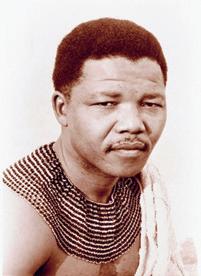


At his trial he said: ‘During my lifetime I have dedicated myself to the struggle of the African people. I have an ideal of a democratic and free society. It is an ideal which I hope to live for and achieve. It is also an ideal for which I am prepared to die.’
He spent 27 years in jail becoming the world’s most famous prisoner. The prison on Robben Island was the toughest in South Africa; meant only for the most dangerous prisoners. Nelson started a programme of self-education for the prisoners. The prison became known as ‘Island University’. He also continued to work against apartheid by smuggling letters out of prison. Meanwhile his supporters worldwide worked for his release.

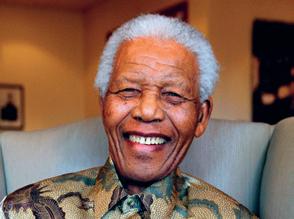
Nelson was finally released in 1990 by President F.W. de Klerk. Together they took apart the apartheid system. In 1993 they got the Nobel Peace Prize for bringing racial equality and democracy to South Africa. A year later, Nelson Mandela became the country’s president serving until 1999.


trial rättegång dedicate oneself to engagera sig i struggle kamp achieve uppnå self-education självstudier meanwhile under tiden worldwide över hela världen release frigivning
He worked tirelessly after the end of apartheid for reconciliation between the people of South Africa promoting peace and forgiveness as the way to heal the scars of the past. Perhaps this is the reason he moved from just being a president to becoming a symbol of hope and freedom in people’s minds.
bring införa racial equality jämlikhet mellan raser serve tjänstgöra tirelessly outtröttligt reconciliation försoning promote verka för forgiveness förlåtelse heal läka scar ärr the past det förflutna
» Greetings from Fantastic Vancouver in British Columbia, Canada
I’mChalea Kepatanic and I’m fifteen years old. I want to tell you about my city and how great it is. Vancouver is on the west coast of Canada and is the largest city in British Columbia. It’s a coastal town with a harbour, placed between the mountains and the ocean. Vancouver is a city with a great heart, and one of the best places in the world to live! Here you can go skiing and snowboarding in the morning, watch whales on a harbour cruise ship as you eat your lunch, then go hiking in the sun in the afternoon. We just love the outdoors and all sports.
Our family lives close to Stanley Park; one of my mum’s favourite things is to take the whole family on the 10 km cycle ride around the seawall. There are great views of the mountain, the ocean and the city. In the summer we stop for a picnic, then we visit the Vancouver Aquarium Marine Science Centre, one of North America’s five largest aquariums.
There are loads of places to visit like Gastown, the old part of the city, the Capilano Suspension Bridge and Grouse Mountain, The Vancouver Lookout is 130 metres high – a great place to view the city. Vancouver has loads of museums and my favourite is the UBC Museum of Anthropology which is full of First Nations totem poles and carvings. There are lots of places to visit and every few months our family goes to a new attraction or museum. We started three years ago and there is still more to see and do.
Living in a city is different to visiting and I love living here. For me it’s the people; we are warm and friendly and there is always something to do from concerts by rock bands to theatres in the park. e for

harbour hamn cruise ship kryssare go hiking vandra the outdoors här: att vara ute i det fria
seawall skyddsmur mot havet view utsikt loads of massor av
anthropology antropologi läran om människans natur carving träskulptur attraction sevärdhet is nicknamed kallas
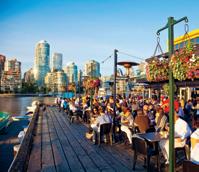
– Just the Facts!
%& Vancouver city has a population of over 640,000 people.
g The Greater Vancouver area has 2.3 million people living in it.
h The third largest movie industry in North America after LA and New York.
l Vancouver is nicknamed Hollywood North.
52% of the people do not speak English as their first language.


Dina and Brian are travelling around the world. They are just about to arrive in Vancouver.
DINA So what is there to do in Toronto?
BRIAN I have no idea – we’re going to Vancouver.
DINA Are we? Oh yes, I was holding the map upside-down. So what can we do in Vancouver?
exhibition utställning you name it allt man kan tänka sig art konst ferry färja canuck kanadick (spec franskkanadensare) downtown centrum
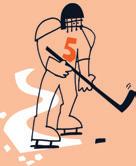
BRIAN What can’t we do? The city has everything! Cafés, shopping, exhibitions... you name it, it’s here.
DINA Does it have any art galleries?
BRIAN Yes, a big one right in the centre of town.
DINA Does it have any parks?
BRIAN Yep – Vanier – just over the water on the ferry.
DINA Good food?
BRIAN No problem – you can eat food from all over the world.
DINA Cool. How about sport?
BRIAN Of course. Ice hockey is a big sport here. We can go and see the Vancouver Canucks play at Rogers Arena in downtown.
DINA That would be great. This city does have everything. Just one thing though.
BRIAN What’s that?
DINA Why does a team called the Vancouver Canucks play in the city of Toronto?
BRIAN Dina!












ISBN 978-91-47-10429-1
© 2013 Annika Bayard, Andy Coombs, Roland Hagvärn, Kjell Johansson och Liber AB. Text- och datautvinning ej tillåten.
projektledare och redaktör Ulrika Wendéus
formgivning och omslag Sara Ånestrand bildredaktör Mikael Myrnerts illustrationer Lene Due Jensen produktion Christina de Besche omslagsfoto Pichugin Dmitry/Shutterstock
Första upplagan
7
repro Repro 8 AB, Stockholm tryck People Printing, Kina 2024
KOPIERINGSFÖRBUD
Detta verk är skyddat av upphovsrättslagen. Kopiering, utöver lärares och elevers begränsade rätt att kopiera för undervisningsbruk enligt BONUS-avtal, är förbjuden. BONUS-avtal tecknas mellan upphovsrättsorganisationer och huvudman för utbildningsanordnare, t.ex. kommuner och universitet. Intrång i upphovsmannens rättigheter enligt upphovsrättslagen kan medföra straff (böter eller fängelse), skadestånd och beslag/förstöring av olovligt framställt material. Såväl analog som digital kopiering regleras i BONUS-avtalet. Läs mer på www.bonuscopyright.se.
Liber AB, 113 98 Stockholm
Kundservice tfn 08-690 90 00
Kundservice.liber@liber.se www.liber.se
Bildförteckning:
Slow Images/Getty Images 5
Christopher Arnesen/Stone/Getty Images 7(1)
Blue Jeans Images/Getty Images 7(2)
Eric Isselee/Shutterstock 8
Nikolay Neveshkin/Shutterstock 9
Andreja Donko/Shutterstock 10
API/Gamma-Rapho/Getty Images 12
Debbie Yazbek/Nelson Mandela Foundation/AFP/Scanpix 13
Rolls Press/Popperfoto/Getty Images 14
Gideon Mendel/Corbis/Scanpix 15
Viktor Gladkov/Shutterstock 19
Fotohunter/Shutterstock 20
Stuart Dee/The Image Bank/Getty Images 21
Jamie Evans/Vetta/Getty Images 23
Alexander Raths/Shutterstock 30(1)
karen roach/Shutterstock 30(2)
Jean-Pierre Pieuchot/Photographer’s choice 31
Dan Persson/Maskot/Scanpix 33
Herman Agopian/Riser/Getty Images 37
Lori Sparkia/Shutterstock 40
Pando Hall/Photgraphers Coice’s RF/Getty Images 41
Africa Studio/Shutterstock 42
Atsuko Tanaka/Corbis/Scanpix 43
Wuttichok Painichiwarapun/Shutterstock 44(1)
SOMKKU/Shutterstock 44(2)
T.D./Shutterstock 45(1)
Venus Angel/Shutterstock 45(2)
Kankaitom/Shutterstock 48
Sheldon Levis/Photolibrary/Getty Images 50
David Ellis/Aurora/Getty Images 53
Tetra Images/Getty Images 54
Jonie Miles/Stockbyte/Getty Images 55
Michael Wong/Photographer’s choice/Getty Images 56
Image Source/Getty Images 57
Steven E. Frischling/Getty Images 58
Finn O’Hara/Photonica/Getty Images 59
Massimo Bettiol/Getty Images 60
PA Wire/Press Association Images/Scanpix 62
Luke MacGregor/Reuters/Scanpix 63
Kelly Ryerson/Stone/Getty Images 67
Catherine MacBride/Flickr/Getty Images 69
Sealman 72
Evening Standard/Hulton Archive/Getty Images 73(1)
Bentley Archive/Popperfoto/Getty Images 73(2)
H. John Maier Jr.//Time Life Pictures/Getty Images 74
iStockphoto/Getty Images 75(1)
Katran/Shutterstock 75(2)
Benoit Monceau/Photonica/Getty Images 77
George Rose/Getty Images 78
Gary Hunter/Photographer’s choice/Getty Images 81
Oliver Berg/EPA/Scanpix 83
Hasbro/Ferrari Press /Scanpix 86(1)
Valentina R./Shutterstock 86(2)
Zemler/Shuttestock 87
Andrey Eremin/Shutterstock 88
Fuse/Getty Images 90
Susanne Walström/Johner/Getty Images 91 fold.it 93
Adrian Weinbrecht/Stone+/Getty Images 97
Martin Parr/Magnum/Parr 98(1)
Steve Lupton/Corbis/Scanpix 98(2)
Alexandra Grablewski/Botanica/Getty Images 99(1)
Camarena/Imagesource/Scanpix 99(2)
Luciano Mortula/Shutterstock 102(1)
Omers/Shutterstock 102(2)
Andreas Rentz/Getty Images 103
Cameron Spencer/Getty Images 107
Rolf Richardson/Robert Harding/Scanpix 108
R. Ian Lloyd/Masterfile/Scanpix 109
Gary Isaacs/Photonica/Getty Image 111
Steve And Donna O’Meara/National Geographics/Getty Images 112
Samantha T. Photography/Flickr/Getty Images 117
Pixtal/Scanpix 118
Bryan Mullennix/Photographer’s choice/Getty Images 120
Fuse/Getty Images 122
Ingolf Pompe/Look/Getty Images 123
Omslag: Pichugin Dmitry/Shutterstock
Textkällor:
“Two Weeks with the Queen” by Morris Gleitzman (Puffin Books, 1989).
Copyright© Gleitzman McCaul, Pty, 1989, p. 16.
“Just a Couple of Kisses” from ”Here’s to you, Rachel Robinson”, Copyright 1993 by Judy Blume. Reprinted by permission of William Morris Agency, Inc., on behalf of the authors, p. 34
“Letter from the Inside” from “Letters from the Inside” by John Marsden.
Copyright 1995 by John Marsden. Reprinted by permission of the author, p. 75
“Christmas in Australia” by Andrew Thelander, p. 106
“Maundy Thursday” by Julie Lerpiniere, p. 112
“Shatterproof” by Jack Ritchie Originally appeared in “Manhunt”, 1960; reprinted by permission of the Author Estate and the Sternig & Byrne Literary Agency, p. 117
Good Stuff GOLD A-D (för år 6-9) är känd för sina sprakande lekfulla texter och sin tydliga, lättjobbade struktur. I Good Stuff GOLD finns mycket realia, rikligt med övningar på olika nivåer, lite mer omfattande övningar och projekt, fler hörövningar, lektionstips och tester till alla texter.
Good Stuff GOLD C (år 8) består av:

Textbook
Workbook
Digitalt elev- och lärarmaterial
För samtliga delar i serien se liber.se.
Good Stuff GOLD – taking it further!
fungerar väl med lgr22